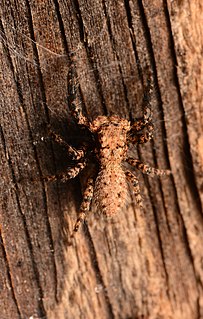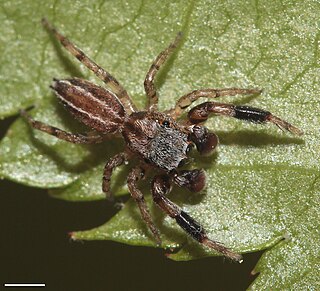
Evarcha culicivora is a species of jumping spider found only around Lake Victoria in Kenya and Uganda. At maturity, E. culicivora spiders have an average size of 5 mm for both males and females. The range in size for either sex is quite small, with females being only slightly larger on average.

Cosmophasis umbratica is a species of jumping spider found in South and Southeast Asia. These spiders are known for their brilliant, shiny ultraviolet light. They are members of the family Salticidae and the genus Cosmophasis. They are commonly spotted on green vegetation. C. umbratica shows extreme dimorphism when viewed under UV light: males reflect UV on all body parts that are displayed during intraspecific interaction, while females and juveniles do not reflect UV at all. It seems that C. umbratica uses this in sexual signaling. A similar phenomenon is found in some butterflies. For example, several species of Colias and Gonepteryx, both of the family Pieridae, also display sexual signaling.

The queen coris, also known as the sand wrasse, Queen coris wrasse, Formosan coris, Formosa coris wrasse, Formosa wrasse, Indian Ocean wrasse or Indian sand wrasse, is a species of wrasse native to the Indian Ocean from the Red Sea and the coast of east Africa to Sri Lanka. This species appears in the aquarium trade due to its vibrant colors. A special feature about this species is how much they change from juvenile to adult form, in color, behaviour, and diet.

Marpissa pikei is a species of jumping spider that is found in the eastern United States, Texas, New Mexico, Arizona and Cuba.

Habronattus cognatus is a species of spider in the family Salticidae. It is found in North America.

Phidippus insignarius is a species of jumping spider in the family Salticidae. It is found in the United States.

Platycryptus arizonensis is a species of jumping spider in the family Salticidae. It is found in the United States.

Phidippus texanus is a species of jumping spider in the family Salticidae. It is found in the United States and Mexico.

Habronattus orbus is a species of jumping spider in the family Salticidae. It is found in the United States.

Habronattus texanus is a species of jumping spider in the family Salticidae. It is found in the United States and Mexico.
Marpissa robusta is a species of jumping spider in the family Salticidae. It is found in the United States.
Marpissa obtusa is a species of jumping spider in the family Salticidae. It is found in the United States.

Phidippus carolinensis is a species of jumping spider in the family Salticidae. It is found in the United States and Mexico.

Marpissa bina is a species of jumping spider in the family Salticidae. It is found in the United States.

Tutelina harti is a species of jumping spider in the family Salticidae. It is found in the United States and Canada.

Talavera minuta is a species of jumping spider in the family Salticidae. It is found in Russia, Canada, and the United States.

Chalcoscirtus diminutus is a species of jumping spider in the family Salticidae. It is found in the United States.

Marpissa lineata is a species of jumping spider in the family Salticidae. It is found in the United States.

Hentzia palmarum, the common hentz jumper, is a species of jumping spider in the family Salticidae. It is found in North America, Bermuda, the Bahamas, and Cuba. They seem to have made it The Hawaiian Islands as well.

Carrhotus viduus is a species of spider in the family Salticidae. It is found in South and Southeast Asia. It is the type species of the genus Carrhotus.






















